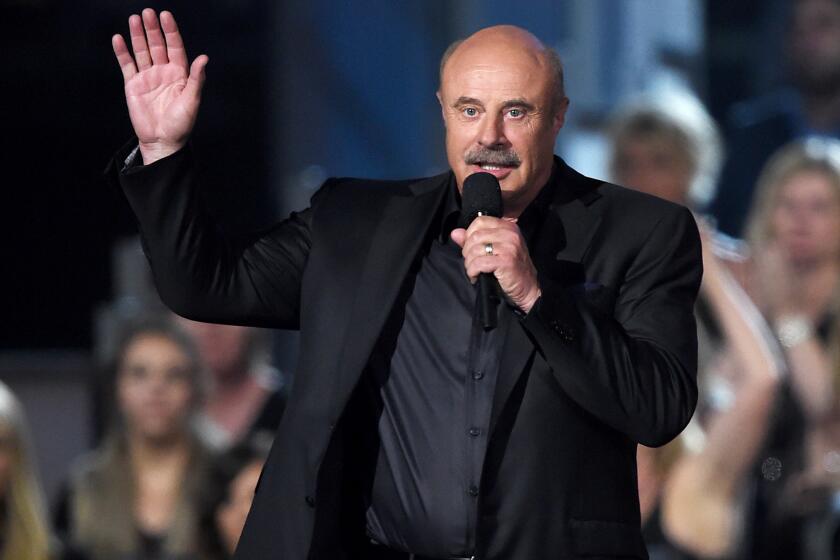Following in Mr. B’s footsteps, for 12 hours
- Share via
NEW YORK — Just past 11 a.m., nine advanced students from the School of American Ballet began the daily ritual of a class. But as they meticulously unfolded their long legs, no mirrors enabled them to check their alignment. Instead, the pensive face of a young George Balanchine watched from a backdrop.
Thus began “Wall to Wall George Balanchine,” a richly illuminating, nonstop 12-hour program held onstage at New York’s Symphony Space on Saturday to mark the great choreographer’s centennial. The event was a parade of performances, panel discussions, lectures and video presentations. It concluded at 11:05 p.m. with six New York City Ballet dancers in the concert adaptation of “Who Cares?,” a 1970 ballet set to Gershwin tunes that was Balanchine’s heartfelt salute to American verve and to Manhattan in particular.
The day was also filled with nostalgia for many in the audience, as City Ballet favorites from the 1950s and ‘60s appeared to reminisce about and discuss the Balanchine masterworks they once danced.
Arthur Mitchell, Edward Villella, Violette Verdy and Jacques d’Amboise were welcomed like returning heroes when they took the stage. But beyond bringing back memories of great dancing, they illustrated the important role they now play -- as artistic directors, teachers and stagers -- in keeping the Balanchine repertory alive. Their presence added layers of history and memory to the present-day offerings onstage. A performance by Dance Theatre of Harlem’s Alicia Graf and Kip Sturm of the out-on-the-edge “Agon” pas de deux came immediately after Mitchell, on whom it was choreographed in 1957, discussed the ballet’s creation.
Coaching sessions by celebrated Balanchine ballerinas Violette Verdy and Merrill Ashley showed young dancers learning the finer points of a ballet from veterans, illustrating how ballets can really be taught only firsthand, body to body. Verdy, a noted interpreter of Balanchine’s 1949 “Firebird,” guided current City Ballet principal Maria Kowroski through the Firebird’s entrance solo, stressing the sharpness of the movement. “Your entrance shows who you are, what powers you have,” Verdy said. She offered such interpretive details as “use the palm of your hand as large feathers -- the little flickers of the hand are minor feathers.”
Over the last decade, the George Balanchine Foundation has assembled a video archive of such coaching sessions by original interpreters. Saturday’s program also included excerpts from those tapes (now available at 60 research libraries around the world), which can convey crucial, utterly nonverbal information in a few minutes. In one, Todd Bolender, the original dancer of the “Phlegmatic” section of “The Four Temperaments” (1946), showed City Ballet’s Albert Evans exactly how to sag and droop lethargically.
In his opening remarks, Isaiah Sheffer, artistic director of Symphony Space, noted that the day was beginning in accordance with the now-famous dictum attributed to Balanchine for bringing serious ballet to America: “But first, a school.” The students from the School of American Ballet, widely considered the nation’s leading such academy, went through their rigorous paces in a compressed class taught by the dynamic Suki Schorer, who conveyed with wit and precision the kind of key illustrative phrases and images Balanchine offered in his classes. Another contingent of students from the school danced excerpts from Balanchine works, setting up intriguing resonances. Giovanni Villalobos, for instance, performed the second solo from the groundbreaking 1928 “Apollo,” which was seen in its entirety eight hours later.
These and many other aspects of the event illustrated the idea of a continuing legacy, which Sheffer identified as the day’s theme. Now a historical personage regarded as one of the 20th century’s leading creative figures, Balanchine, who died in 1983, nonetheless retains relevance as the maker of works that continue to challenge and reward dancers and audiences worldwide. That made him an ideal choice to be the first choreographer saluted in one of Symphony Space’s annual “Wall to Wall” programs, which have focused on composers since they began in 1978.
In addition to the performances and demonstrations, panels and lectures focused on Balanchine’s pre-U.S. years with Russian impresario Sergei Diaghilev; his long collaboration with composer Igor Stravinsky; and the role that City Ballet co-founder Lincoln Kirstein played in his career. Readings from the autobiographies of early Balanchine muses Tamara Geva and Alexandra Danilova, and by Villella and Allegra Kent from their own memoirs, were poignant and insightful.
The final, three-hour segment was dominated by performances -- necessarily to taped music since Symphony Space, a converted movie theater, has no orchestra pit. Dance Theatre of Harlem gave the New York premiere of its “Apollo,” staged by Eve Lawson and coached by D’Amboise, who restored details he knew from the 1950s that have fallen away over the years. Rasta Thomas, as the still-unformed young god, faultlessly stumbled on a step that he would later, as the more mature Apollo, execute nobly.
“Renard,” an unfamiliar 1947 work that Balanchine created to a jaunty Stravinsky score, came back to life in Kansas City Ballet’s charming restoration, staged by Bolender of the original cast. Now 90, he was present to introduce it.
With free admission and unreserved seating, “Wall to Wall Balanchine” kept Symphony Space’s 750 seats well occupied throughout the day. By 4 p.m., a line of hopeful audience members stretched for a block outside, and competition for seats for the evening portion was intense. Officials at Symphony Space estimated that total attendance was about 3,000.
Backstage, Sheffer reported, “many emotional reunions” took place. For one exhilarated patron leaving at the end, who noted that he had been watching Balanchine’s ballets since the late 1950s, the experience “was like going back in time.”
More to Read
The biggest entertainment stories
Get our big stories about Hollywood, film, television, music, arts, culture and more right in your inbox as soon as they publish.
You may occasionally receive promotional content from the Los Angeles Times.










